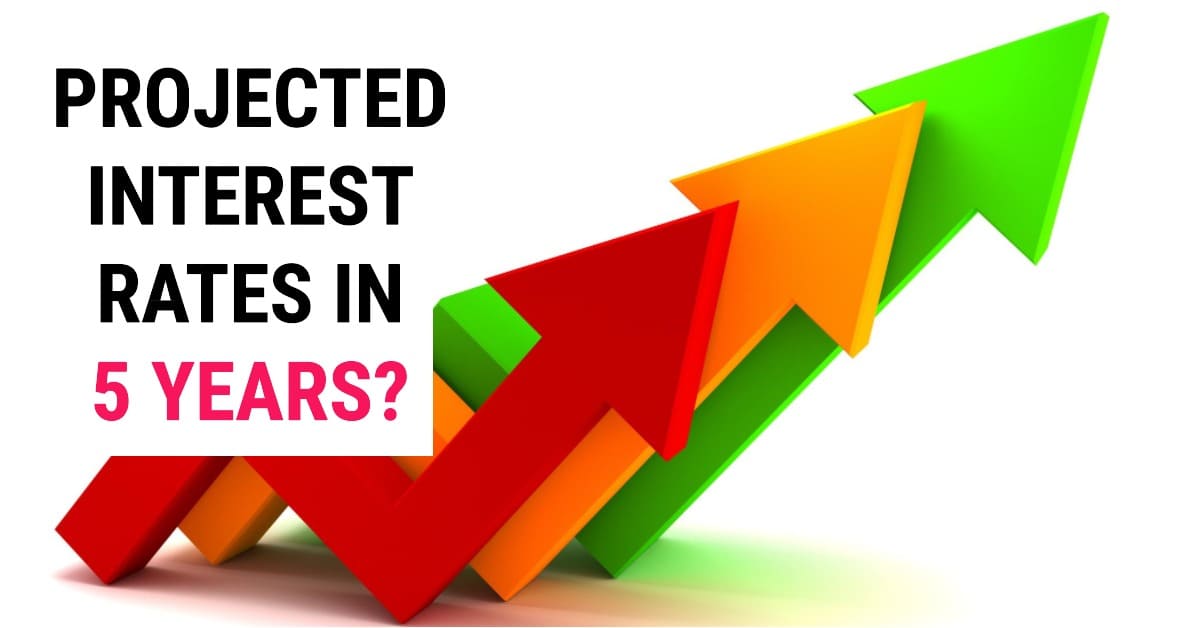What will interest rates look like in 5 years? Let's explore the forecasts for mortgages, auto loans, credit cards & global trends. The short answer regarding projected interest rates in 5 years is this: we're likely to see them gradually decline, though they probably won't hit the ultra-low levels we were used to pre-pandemic.
It’s a nuanced picture, not a straight downward slide, and factors like inflation and global economic events will play a huge role. So, if you're trying to figure out how this will impact your mortgage, car loan, or even just your savings, stick with me as I break down what the experts are predicting, and share some thoughts on what it all means.
Projected Interest Rates in 5 Years: A Look at the Forecasts
I know it might feel like we're all just guessing, and to some extent, we are – economic forecasting is tricky! But by looking at what central banks are doing, and considering the bigger trends in the economy, we can get a pretty good sense of the direction things are heading. I've spent a lot of time following financial markets, and I can tell you this much: even though economists don't always get it right, understanding these predictions is crucial for planning your finances. So, let's get into it, shall we?
The Federal Reserve's Hand in the Game
The U.S. Federal Reserve (the Fed) is like the conductor of the financial orchestra, and right now, they're carefully adjusting the tempo. After aggressively hiking rates in 2022 and 2023 to tackle inflation, they started to ease up a bit in late 2024. They've started cutting the federal funds rate, which is a key benchmark for many other interest rates. However, instead of the originally anticipated four rate cuts in 2025, they're now only projecting two.
Why this cautious approach? Well, even though inflation has come down significantly, hitting 2.2% in August 2024, the Fed is still worried about it coming back to haunt us. They have a dual mandate: keeping prices stable and making sure everyone who wants a job can find one. It's a tricky balancing act!
The experts who make up the Fed see the federal funds rate settling at around 3.4% by the end of 2025. But, that's just an average, and some of them think it could be as low as 2.75% or as high as 4.25%. This range shows how uncertain things still are and that nobody has a crystal ball.
Here’s what it looks like:
- 2022-2023: Aggressive Rate Hikes
- Late 2024: Rate Cuts Begin
- 2025: Projected Two Rate Cuts
- End of 2025: Median forecast of 3.4% for the federal funds rate
Mortgage Rates: A Slow and Steady Decline
Now, what about mortgages? These are probably on the minds of many. Mortgage rates are closely linked to the yields on long-term U.S. Treasury bonds, and these yields are also expected to go down over the next five years. But, don't expect a sudden drop – it’ll be more of a gradual easing.
Wells Fargo and Fannie Mae predict that a 30-year fixed mortgage will be around 6.3% in 2025. It's a step down from the 7% that's common right now, but still much higher than the 4% that many of us were used to. By 2027, Morningstar is forecasting a further drop to 4.75%. This easing will likely be driven by the Fed continuing to lower rates, plus people becoming more confident that inflation is under control.
While this gradual drop is good news for homebuyers, affordability will still be a big problem. Even if rates go down a little, house prices are still quite high, and there just aren't enough houses available. It’s a complex situation that isn't going to be solved overnight.
Mortgage Rate Predictions:
- 2024: Around 7%
- 2025: Around 6.3%
- 2027: Around 4.75%
Auto Loans and Credit Cards: A Mixed Bag
Let's turn our attention to car loans and credit cards. Here, we're seeing a similar trend to mortgages, but with a few differences.
Auto loan rates are also expected to decline a little in 2025. The average rate for a five-year new car loan might drop from 7.53% in 2024 to about 7% in 2025. It's not a huge change, but it's something. Credit card interest rates, which can be very sensitive to the federal funds rate, are also predicted to dip slightly, with the average APR dropping to 19.8% by the end of 2025.
Even with these small decreases, it's important to realize that borrowing money for cars and credit cards will still be costly. These rates will be higher than what we saw before the recent inflation spike and shows the impact of the Fed’s rate decisions.
Auto and Credit Card Rates
- Auto Loan Rates: Projected to decline modestly to around 7% in 2025.
- Credit Card Rates: Expected to decrease slightly to 19.8% by end of 2025.
Global Central Banks Are Singing the Same Tune
It’s not just the Fed that’s making moves. Other major central banks around the world are heading towards easing monetary policy, which usually means lowering interest rates. The European Central Bank (ECB) and the Bank of England (BOE) are both expected to cut rates in 2025. The ECB is projected to reduce rates by 148 basis points, and the BOE by 85 basis points.
But, there’s always an outlier! The Bank of Japan (BOJ) seems to be going in the opposite direction. They might have to raise rates because of persistent inflation and a weak currency. This tells us that different countries face different economic realities.
Global Interest Rate Projections
- ECB: Projected to cut rates by 148 basis points in 2025
- BOE: Projected to cut rates by 85 basis points in 2025
- BOJ: Likely to raise rates
The Long View: Lower Rates in the Long Run
If we look beyond the next couple of years, things point to a general move back to lower interest rates. Morningstar thinks that the federal funds rate will stabilize around 2.00%-2.25% by 2026, while long-term Treasury yields could decline to around 3% by 2027.
Why this long-term decline? Well, experts believe that deeper trends are at play, including:
- Aging demographics: Older populations tend to save more and invest in lower-risk options, which puts downward pressure on rates.
- Slower productivity growth: Lower productivity can lead to lower economic growth and therefore lower interest rates.
- Higher economic inequality: When income is concentrated in fewer hands, overall demand can be lower, leading to lower interest rates.
These are structural issues that won't go away anytime soon, and they're likely to keep a lid on interest rates for the foreseeable future.
Risks That Could Throw Things Off Course
As I said before, forecasting is tricky. There are several things that could mess up our predictions of lower interest rates:
- Inflation Resurgence: If inflation gets out of hand again because of supply chain problems or international tensions, central banks might have to halt or even reverse their rate cuts.
- Economic Shocks: A big global recession or another financial crisis could cause rates to drop rapidly as central banks attempt to stimulate the economy.
- Policy Changes: A new government could mean a completely different approach to fiscal and monetary policy, affecting the interest rate path. The 2024 U.S. presidential election, for example, could have a major impact.
These are just a few of the things that could make our predictions less accurate. It's really important to be aware of these potential risks, because they can have a big impact on our finances.
My Final Thoughts and Advice
After digging into all these predictions, here’s what I think: we’re definitely going to see interest rates moving downwards over the next five years, but it’s going to be a gradual, sometimes bumpy, ride. It won’t be a return to rock-bottom rates anytime soon.
Here's what I think you should do:
- For Consumers: This is a good time to focus on paying down debt and building a strong credit score. Shopping around for the best rates can make a big difference, and don't just accept the first offer that you see.
- For Investors: Look into bonds, as they might do better than cash as yields decline and inflation stabilizes. Diversify your portfolio so that you’re protected from a downturn.
- Stay Informed: Economic situations change rapidly. So, keep reading articles, listening to financial news, and adapting your strategies as needed.
The economy is a complicated beast, and predicting the future is hard. But by staying informed and being prepared for whatever might come, we can all navigate these choppy economic waters a bit better. It’s all about learning from the past and being adaptable for the future.
- Interest Rate Predictions for the Next 3 Years
- Interest Rate Predictions for Next 2 Years: Expert Forecast
- Interest Rate Predictions for Next 10 Years: Long-Term Outlook
- When is the Next Fed Meeting on Interest Rates?
- Interest Rate Cuts: Citi vs. JP Morgan – Who is Right on Predictions?
- More Predictions Point Towards Higher for Longer Interest Rates



